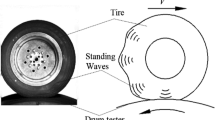Abstract
Generated axial force (GAF) induced by internal friction in a tripod constant velocity (CV) joint causes shudder, which is related to lateral vibration in a vehicle. GAF is produced by tripod dynamics in the CV joint, and its magnitude is related to an applied torque and articulation angle. GAF provides periodic frictional force, owing to its kinematics, and causes take-off shudder that occurs when a vehicle abruptly accelerates from a stop position. Therefore, accurately estimating the GAF in a CV joint is necessary. A non-rotating type GAF measurement tester is developed to measure GAF more accurately, considering the shudder condition. Results of GAF measurements are compared with those obtained using an existing rotating-type tester. The developed tester provides linear results regardless of test conditions; thus, it can be used to estimate the magnitude of GAF and evaluate the friction performance of grease.
Similar content being viewed by others
References
Y. H. Lim, M. E. Song, W. H. Lee, H. J. Cho and D. S. Bae, Multibody dynamics analysis of the driveshaft coupling of the ball and tripod types of constant velocity joints, Multibody Syst. Dyn., 22 (2009) 145–162.
C. H. Lee and A. A. Polycarpou, A phenomenological friction model of tripod constant velocity (CV) joints, Tribology International, 43 (2010) 844–858.
C. H. Lee, Measurement and characterization of friction in automotive driveshaft joints, Int J Automot Technol., 8(6) (2007) 723–730.
S. Serveto, J. P. Mariot and M. Diaby, Modelling and measuring the axial force generated by tripod joint of automotive drive-shaft. Multibody Syst. Dyn., 19 (2008) 209–226.
J. S. Sa, T. W. Kang and C. M. Kim, Experimental study of the characteristics of idle vibrations that result from axial forces and the spider positions of constant velocity joints, Int. J. Automot. Technol., 11(3) (2010) 355–361.
Q. C. Cai, K. H. Lee, W. L. Song, C. H. Lee and Y. Lee, Simplified dynamics model for axial force in tripod constant velocity joint, Int. J. Automot. Technol., 13(5) (2012) 751–757.
J. P. Mariot, J. Y. K’nevez and B. Barbedette, Tripod and ball joint automotive transmission kinetostatic model including friction, Multibody Syst. Dyn., 11 (2004) 127–145.
H. Sugiura, T. Matsunaga, Y. Mizutani, Y. Ando and I. Kashiwagi, Thrust force analysis of tripod constant velocity joint using multibody model, Journal of System Design and Dynamics, 3(6) (2009) 975–985.
C. H. Lee, Development of a semi-empirical friction model in automotive driveshaft joints, Int. J. Automot. Technol, 9(3) (2008) 317–322.
Author information
Authors and Affiliations
Corresponding author
Additional information
Recommended by Editor Yeon June Kang
Chul-Hee Lee is an associate professor in the Department of Mechanical Engineering, Inha University. He received his Ph.D. in Mechanical Engineering from the University of Illinois at Urbana-Champaign. His research interests include tribology and virtual product development in mechanical systems.
Rights and permissions
About this article
Cite this article
Lee, KH., Lee, DW., Chung, JH. et al. Design of generated axial force measurement tester for tripod constant velocity joints under shudder condition. J MECH SCI TECHNOL 28, 4005–4010 (2014). https://doi.org/10.1007/s12206-014-0913-9
Received:
Revised:
Accepted:
Published:
Issue Date:
DOI: https://doi.org/10.1007/s12206-014-0913-9




